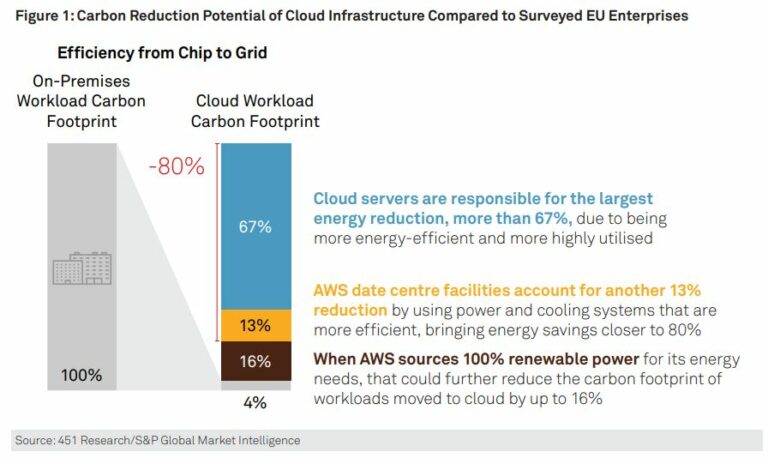The last eight years have been the warmest ever recorded. This is the result of NASA‘s annual analysis of global average temperatures since records began in 1880. “If we do not urgently change our way of life, we are putting life itself at risk,” said United Nations Secretary-General António Guterres.
The climate crisis is caused by us – and the solutions must come from us. We have the tools: the technology is on our side.
Antonio Guterres
To understand how cloud computing helps companies reduce their carbon footprint in the blog article – using AWS as an example.
Cloud computing helps reduce climate-damaging CO₂ emissions
Cloud computing, i.e., the demand-based procurement of IT resources via the Internet, offers options for overcoming these challenges. In contrast to on-premises servers with the associated siloed hardware, power consumption and required cooling systems, the cloud offers significant cost and environmental advantages.
Study shows: Migration to the cloud can reduce your carbon footprint
A study by 451 Research found that European companies can reduce their IT carbon footprint by an average of 80 % by migrating their IT infrastructure from their own data centers to the AWS cloud (see image). Once AWS reaches its goal of sourcing 100 % energy from renewable sources, companies could reduce the carbon emissions of their IT infrastructure by as much as 96 %. This goal should be achieved by 2025.

Further exciting application scenarios for cloud computing to support sustainability
Companies and organisations have the opportunity to use the latest technologies, such as machine learning, without having to operate and manage their own expensive and complex IT infrastructure. Some examples of how cloud computing can be effectively used to achieve sustainability goals:
- Research groups can access storage and computing capacity from the cloud. This enabling them to work together across national borders on consolidated data, in order to combat climate change and its possible consequences.
- The use of sensors in production can monitor water and energy consumption.
- Using the data for machine learning can help optimise energy consumption.
Software companies like d.velop are examples of how cloud computing can be used to achieve sustainability goals. By using cloud infrastructure, d.velop continuously optimises the energy consumption of cloud applications. For example, the CO₂ footprint of d.velop end customers in the cloud is reduced by utilising the central server infrastructure as needed.
Sustainable IT infrastructure with the AWS Cloud
Amazon co-founded The Climate Pledge to build a cross-industry community with the goal of achieving carbon neutrality by 2040. As the world’s largest corporate buyer of renewable energy, Amazon aims to run 100% renewable energy operations by 2025, five years ahead of its original 2030 target. It was only in November 2022 that AWS CEO Adam Selipsky announced AWS’s commitment at the re:Invent customer event to be water positive by 2030. Being water positive means AWS returns more water to communities than it uses in direct operations.
Additional emissions savings can be achieved with energy-efficient server technologies, high utilisation rates, efficient cooling systems and tailor-made hardware in the AWS regions. AWS supports customers with various tools when optimising their IT infrastructure in the cloud:
- For example, the AWS Customer Carbon Footprint Tool helps customers measure, report, and forecast their AWS carbon footprint.
- Furthermore, the sustainability pillar in the AWS Well-Architected Framework, helps minimise the environmental impact of cloud infrastructures and provides proven methods, design principles and guidance for sustainable cloud architectures.
Outlook for more sustainability through cloud computing
Organisations around the world are developing innovative solutions to ensure our planet remains habitable for generations to come. Programs like the Amazon Sustainability Data Initiative (ASDI), aim to accelerate sustainability research and innovation by making a variety of data sets available for free. The time required to acquire and analyse large sustainability data sets is reduced, whilst providing data and tools for researchers and innovators.
The key focus is to benefit from shared learning, gaining global practical experience and maximising shared knowledge, when we combine technology with sustainability.
